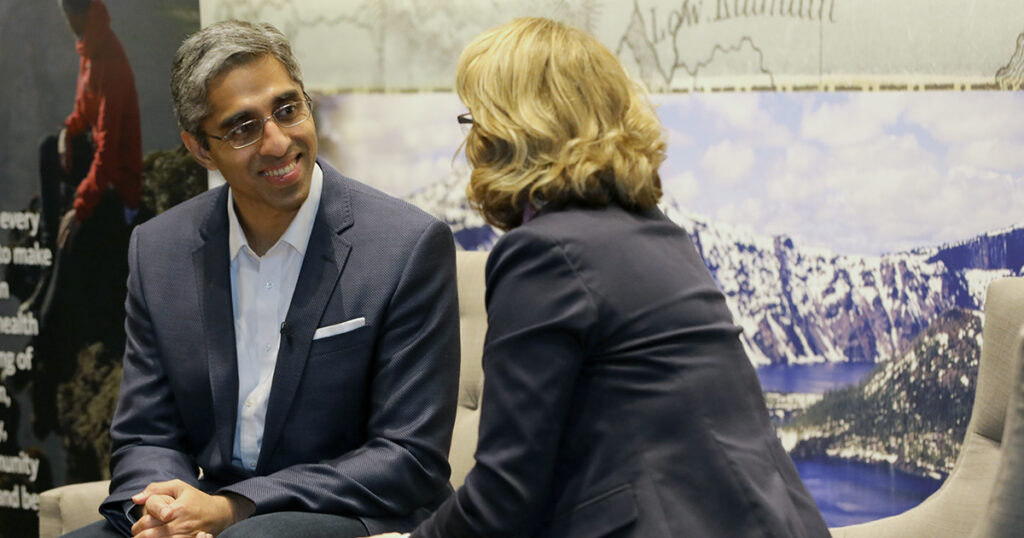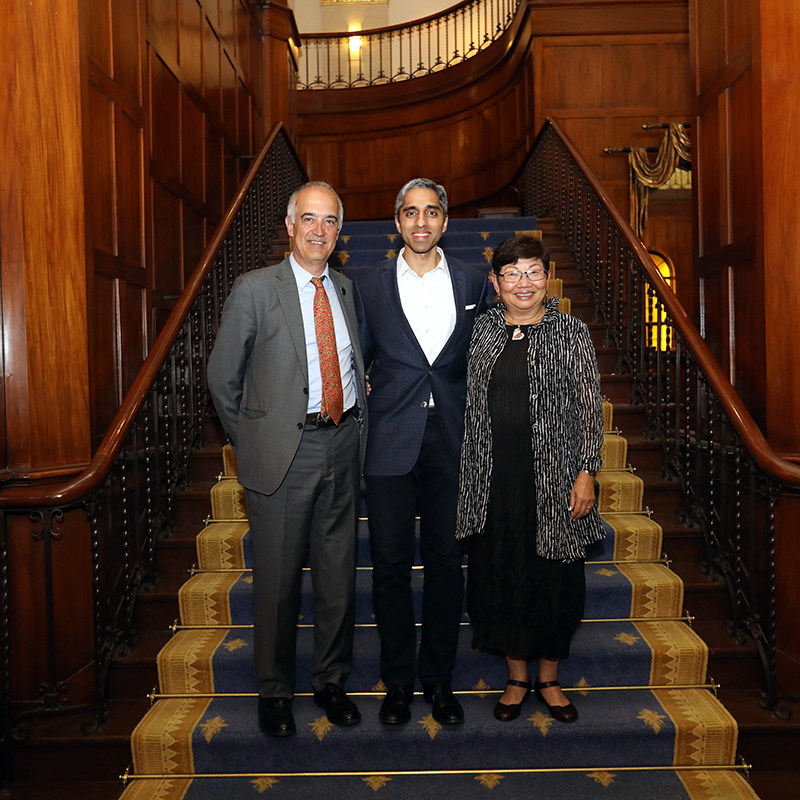
Vivek H. Murthy, MD served as U.S. Surgeon General from 2014-2017, and on December 7, he was once again nominated to that position on the new president’s health team. A former Vice Admiral in the Public Health Service Commissioned Corps, Dr. Murthy serves as co-chair of the President-elect’s COVID-19 transition advisory board.
In 2018, Dr. Murthy became the first speaker in the Bray Health Leadership Lecture series funded by contributions from alumni and supporters. The fund, started by Emeritus Dean Tammy Bray, was created for high-profile health leaders to inspire CPHHS students, faculty and stakeholders.
What follows is a recap of his 2018 remarks, in which, on his first visit to Oregon, Dr. Murthy addressed the importance of mental health and described his circuitous path toward his career as a physician and the nation’s doctor.
It was one moment in particular that set the course for his life’s work.
Imagine: It’s the middle of the night, you’re in Miami, and your mother wakes you up, puts you in the car and drives to a trailer park where she explains your father’s patient died of cancer and they’re worried his widow is grieving alone.
“That captured so much of my own experience and parents’ experience,” he says. “They came to this country not knowing what to expect but hoping there would be a community that would embrace us and opportunities for my sister and me. Hoping that this would be a country where we wouldn’t be judged because we had funny sounding names or dark skin, but by our ability to contribute … our willingness to work hard and reach out and embrace others. I saw in my mother’s embrace that community. I saw a vision and a model of medicine that went beyond a job … more of a calling and sense of community. That’s what inspired me to go into medicine and continues to be my guiding light of what I want to contribute to the world. It’s that kind of love, that kind of relationship that I hope to make a small contribution to.”
Fast forward to July 10, 2013, his birthday, and a call from Washington, D.C., that would take his career as a physician one big step forward. He would be the nation’s 19th Surgeon General.
“I look back at that time in office with extraordinary memories and much gratitude,” he says. “I have loved our country for as long as I can remember for its incredible opportunities. But it was like loving a family you haven’t entirely met. Going to visit communities across the country and seeing this extraordinary sense of kindness, decency and warmth from fishing villages in Alaska to small towns in Missouri, it was the experience of falling in love with America all over again. I feel so grateful for that opportunity and to contribute to the public health of this country.”
And what did he learn in talking with so many Americans? People are hurting.
What’s the problem?
On his listening tour, he would ask, “What’s on your mind? What burdens you most?” What he heard formed a consistent theme: addiction, substance abuse, mental health.
“Emotional well-being is at the root of all we do,” he says. “It drives so much of what we care about when it comes to health, but we have very little discussion about it and very little knowledge about how to promote it, much less see a reflection of that in our programs and policies. That’s a gap we have to close. When you delve even further, the impact goes far beyond health. When you look at our schools, educational outcomes are tied to chronic stress and emotional well-being. Productivity in the workplace is also very much connected to chronic stress and the degrees of loneliness people are experiencing.”

Part of the problem is stigma. “Addressing stigma might seem minor,” he says. “It’s not. It’s the barrier that blocks everything else. If there are legislators who don’t believe that addiction is a real disease, then they’re not going to fund addiction programs and treatments. If there are communities that see it as a moral failing or bad character, then they’re going to oppose treatment centers in their neighborhoods. This is why changing perception is just as important as instituting evidence-based programs.”
Doctors and nurses, he says, often still look at addiction as the patient’s fault. “I asked, ‘How are you treating your diabetes patients? Are you shaming them for not doing better in terms of lifestyle interventions or are you allowing them to have their medications?’ It’s an absurd dichotomy we have between addiction and other chronic illness.”
Another problem, he says, is fear that mental health is seen as “being frivolous, fluffy stuff and not serious stuff.” In contrast, “of all the issues I talked about as surgeon general, there was no issue that resonated more with people than emotional well-being. People are dealing with this personally and know something is not quite right. They may not know how to fix it or what to call it, but they know.”
What we can do?
Dr. Murthy says there are three main areas to address to create change.
Individual
The first is individual, which includes equipping people with tools needed to be emotionally resilient, encouraging social connection, exercise and also sleep. “Exercise can have a positive effect on your mood that can be as powerful as some antidepressants. Sleep, too, often gets dismissed. It’s not a luxury.”
Policy
The second is policy. Changes are needed to address structural factors and support programs that support emotional well-being, he says. Not only can it save money, but doing so can also help improve grades, reduce alcohol abuse and unwanted pregnancy and more. “It’s not just about addiction, it’s about developing skills to enhance emotional well-being.”
Cultural
The third is cultural. It’s also the hardest. “We have to change how we see emotions as a society. Most think they’re a source of weakness, not power. That’s the challenge. Elite athletes know the difference between being good and great is not how much time you spend in the weight room, it’s how you combine your head and your heart and channel your emotions into something productive and positive. How you can use fear and translate it into better output, focus and concentration.”
“If it sounds onerous, if it sounds too hard to do if you’re just one person, we can start making change on these levels person by person, institution by institution,” he says. “As you think about your own work in the world, it is the words you choose to use, it is how you choose to treat other people, it is a culture that you support and choose to build, it is the programs policies and politicians you choose to support based on the values they exhibit. Those are the levers you have to affect our culture and to create a culture that embraces and understands emotional well-being.”